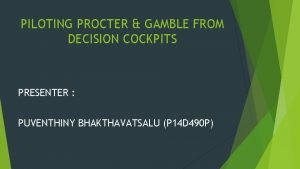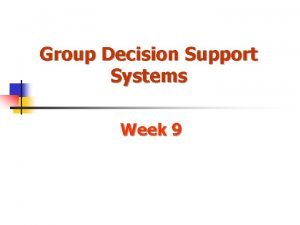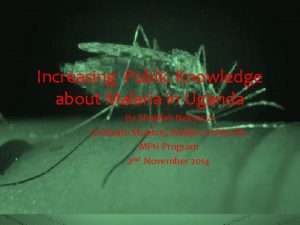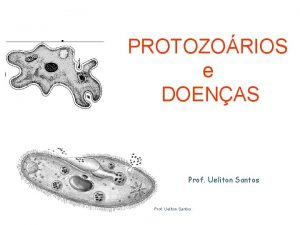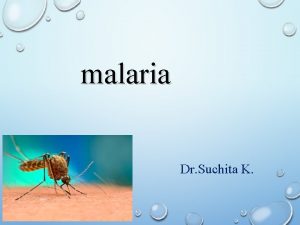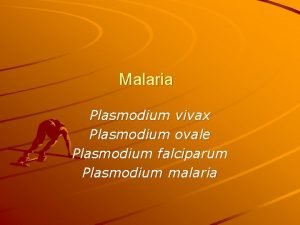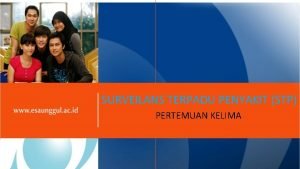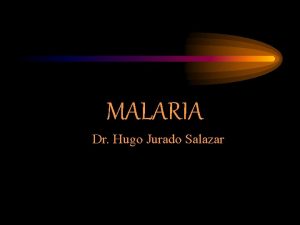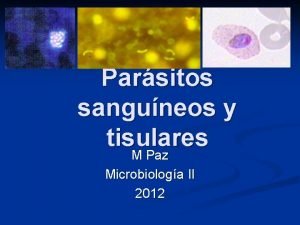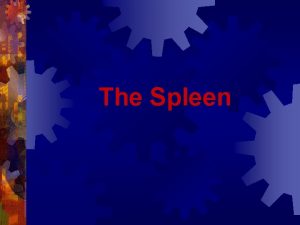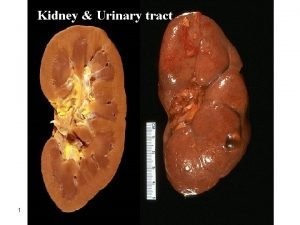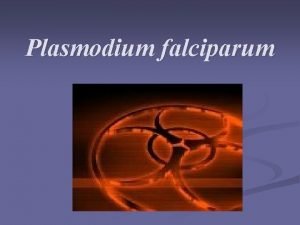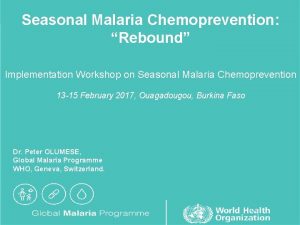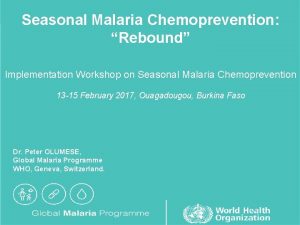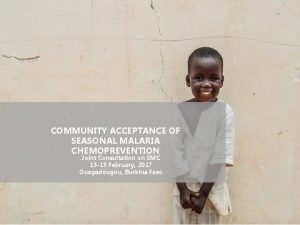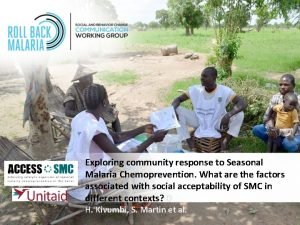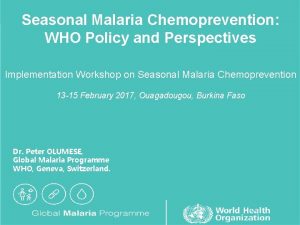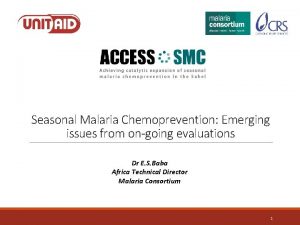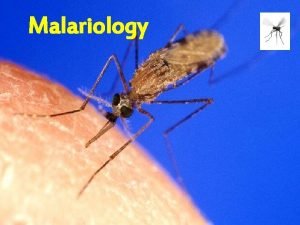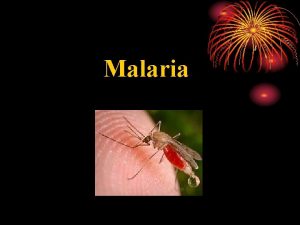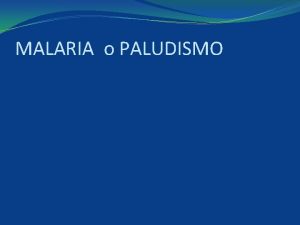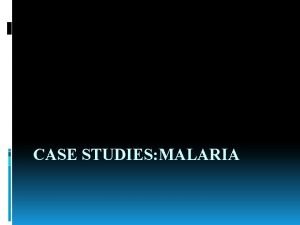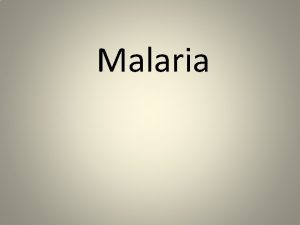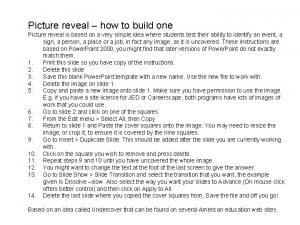Piloting Reveal for use in seasonal malaria chemoprevention














- Slides: 14

Piloting Reveal for use in seasonal malaria chemoprevention in Nigeria Olatunde Adesoro 2020 Annual Meeting of the American Society of Tropical Medicine & Hygiene

Overview • Seasonal malaria chemoprevention (SMC) • Implementing the pilot (usability testing) • The Reveal workflow in SMC • Preliminary coverage results and key findings

Seasonal malaria chemoprevention • Seasonal malaria chemoprevention (SMC) is the administration of full courses of antimalaria medication in areas of highly seasonal malaria transmission. • It prevents malaria episodes by maintaining therapeutic antimalarial drug concentrations in the blood throughout the period of greatest malarial risk. • Typically, SMC is delivered door-to-door by community distributors (CDs) in four monthly cycles to children 3– 59 months. Typical four-cycle SMC treatment round

Implementing SMC in Nigeria • Malaria Consortium has been implementing SMC in Nigeria since 2013. • In 2020, we reached about 10 million children across 176 local government areas (LGAs) in seven states. • 2020 implementation timelines: o Cycle 1: July o Cycle 2: August o Cycle 3: September o Cycle 4: October.

Accurate coverage data and tracking • Some of the challenges of SMC implementation include: o Inaccurate target population estimates for planning o Difficulties in coordinating CDs’ field movements o Inaccurate and untimely coverage data as a result of error arising from paper-based data management. • This leads to inaccurate information on programme coverage, which is essential for maximising effectiveness and ensuring accountability. • Digitisation of SMC data management via the Reveal platform (a geospatial web-based application) is expected to improve data accuracy and optimise intervention coverage. o Spatial mapping to determine the location and number of the target population o Efficient, real-time monitoring of CDs and tracking of coverage o Easy retrieval of electronic data and visuals that will provide accurate intervention coverage information.

Introducing Reveal into SMC implementation Usability testing Assessment and development • • • 1 Stakeholder engagement Scoping exercise Validation workshop Enumeration exercise In-field testing. • Remote training of trainers • Face-to-face health facility and CD training • Implementation in two health facilities 2 o Easy-to-reach o Hard-to-reach • Trialled on two types of devices (Samsung, Tecno) Pilot study Operational research

Usability study Aim: Gather evidence about the usefulness, efficiency and learnability of the Reveal platform to different types of users. Location: One easy-to-reach and one hard-to-reach health facility in Goronyo LGA, Sokoto state. Design: Mixed-methods. Objectives: 1. To understand whether the Reveal platform supports users to complete their specified tasks. 2. To document the efficiency of task completion using the Reveal mobile client. 3. To document users’ competency with the Reveal platform immediately after training and after use. Methods: Focus group discussions, system usability score, think-aloud methodology, extraction and analysis of back-end data. Timescale: September–November 2020. Ethical approval: Sokoto state.

Reveal workflow • Enumeration and mapping: Building structures are identified on satellite maps in SMC distribution areas and loaded onto the Reveal app on the tablets. All structures appear in yellow. • Registration: CDs visit and select a yellow structure, register the structure (as residential/other) and, if residential, register families and children. o CDs can only register structures if they’re nearby. o New structures can be added. • Complete tasks: SMC delivery, re-dosing, referral as applicable for available eligible children. • Complete documentation: Colour of structures changes as visits and distribution progress (see key on next slide).

• Monitor and respond: Supervisors monitor through spatial images and the mobile dashboard and respond accordingly. o Blue: operational area and user (i. e. CD) o Yellow: structure not visited o Red: structure visited, no SMC distributed o Purple: structure visited, SMC partially distributed o Green: structure visited, SMC fully distributed o Black: ineligible (not a residential structure). • Response: Options include: o Planning for next visits o Planning to mop-up yellow structures o Planning to revisit purple structures. • Drug reconciliation: Morning and evening.

Monitoring indicators: Mobile/web dashboards • # total structures • # structures visited • # structures not visited • # structures confirmed eligible • # structures complete drug distribution • # structures partial drug distribution • # children eligible (3– 59 months) • # children treated • Visitation coverage percentage: # structures found/# total • Distribution coverage percentage: # structures distributed/# total • Structure distribution effectiveness percentage: # structures distributed/# found • Children coverage: # children treated/# eligible

Preliminary findings Accurate data generated for eligible children. Easy monitoring and supervision. Electronic distribution route plan. Verifiable complete coverage of structures. Coverage 15 percent higher than previous cycle. Instructional job aid as part of platform. Unique child identifier for treatment history tracking. Untreated children and reason. Dropout rates. Easy drug reconciliation.

Challenges • COVID-19 pandemic prevented implementation and technical teams from working together in person. o All training, app development and set-up were undertaken remotely, at times beyond stipulated periods. • Technical hiccups characteristic of new system development and set-ups (e. g. data synchronisation, up/downloads etc. ). • Internet connectivity issues in the field. • Security, flooding and bad terrain.

Next steps • Continue usability testing in cycle 4 (October) and assessment (November). • Scale up use of Reveal to all operational areas in Goronyo LGA in 2021 SMC implementation. • Conduct implementation research in 2021 to explore the effect of Reveal on the quality of SMC implementation and accuracy of coverage data. • Expected outcomes of the usability testing, introduction, and implementation research: o Guide decision-making around the future use of Reveal in the SMC programme in Nigeria. o Inform the global malaria control community on the utility of Reveal for SMC.

This usability testing was implemented by Malaria Consortium with technical support from Akros and in collaboration with the National and Sokoto State Malaria Elimination Programmes. Funding was provided from Malaria Consortium’s philanthropic funding for SMC. Thank you www. malariaconsortium. org
 Piloting procter & gamble from decision cockpits
Piloting procter & gamble from decision cockpits Piloting procter & gamble from decision cockpits
Piloting procter & gamble from decision cockpits Malaria in uganda facts
Malaria in uganda facts Causative agent malaria
Causative agent malaria Plasmodium sp doença
Plasmodium sp doença Obat malaria dhp
Obat malaria dhp Malaria in pregnancy definition
Malaria in pregnancy definition Fansidar dosis
Fansidar dosis Stp disease
Stp disease Etiologia de malaria
Etiologia de malaria Plasmodium vivax forma infectante
Plasmodium vivax forma infectante Cause of splenomegaly in malaria
Cause of splenomegaly in malaria Trypanosoma bruzi
Trypanosoma bruzi Quartan malaria nephropathy
Quartan malaria nephropathy Plasmodium species malaria
Plasmodium species malaria
